If you’re deciding between carbon steel and cast iron, it’s a good idea to consider their similarities and differences. It may surprise you to learn that carbon steel cookware has less carbon and more iron, whereas cast iron cookware has more carbon and less iron. Carbon steel cookware is 98-99% iron and 1-2% carbon, whereas cast iron has up to 3% carbon and 97% iron.
For the most part, cast iron and carbon steel appear quite similar. Both are made of heavy-duty metal blends that are excellent heat conductors. However, these two are very different in construction, cooking surface, and weight.
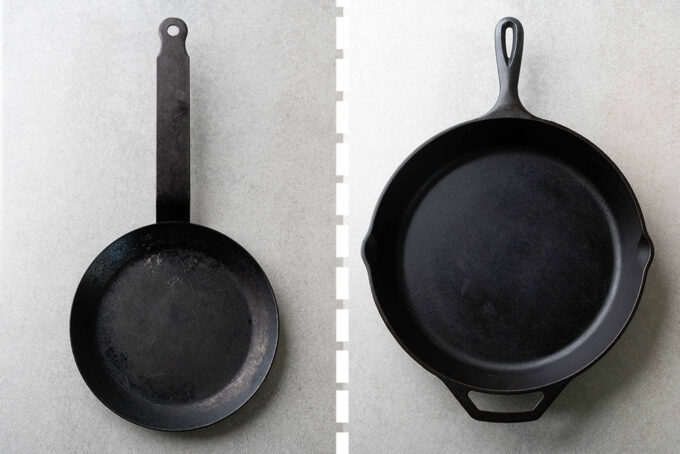
Differences between carbon steel and cast iron
There are numerous similarities between carbon steel and cast iron. They’re both extremely durable, versatile, become more nonstick as you use them, and necessitate special care to keep in top condition. Both have their distinct characteristics.
| Carbon Steel | Cast Iron | |
|---|---|---|
| Weight | 2-6 lb | 4-12 lb |
| Heat retention | heats well but heats and cools down much faster and shorter | heats well but heats and cools down much slower and longer |
| Oven safe | Yes | Yes |
| Fire safe | Yes | Yes |
| Average cost | $45+ | $25+ |
| Lifespan | Lifetime | Lifetime |
Cast iron pans
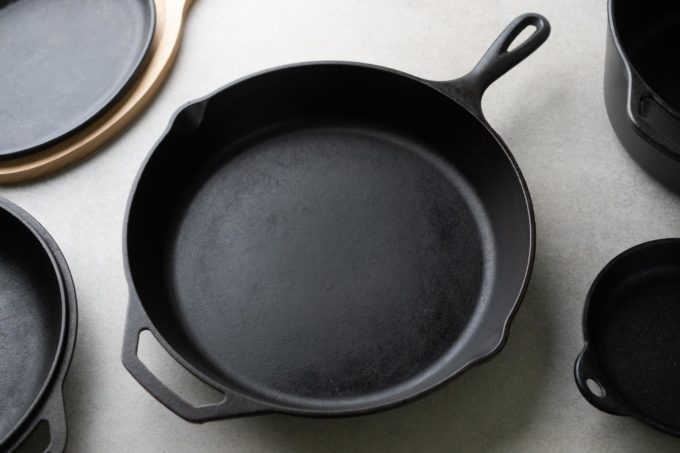
Cast iron cookware was first used in China during the Han Dynasty, around 220 A.D. By the 16th century, casting techniques had spread throughout Europe. This versatile equipment has since become a household staple throughout the world.
Cast iron cookware is made by melting iron and steel, and the carbon concentration is increased by adding chemicals to the mix. It is then poured into a mold made of clay powder, sand, and water. When cast iron cookware cools, the sand mold is removed. Then, each piece is sanded and polished by hand.
Cast iron cookware is long-lasting and difficult to ruin completely. When properly seasoned, we prize cast iron cookware for its heat retention, durability, and ability to withstand extremely high temperatures. In addition, slow-cooking ingredients benefit from the material’s ability to absorb and release heat slowly.
Because cast iron skillets come in so many different shapes, styles, and strengths, deciding which one is best for your kitchen can be a difficult task. Lodge, Le Creuset, and Staub are just a few well-known cast iron cookware manufacturers. So whether you’re on a tight budget or saving up for the next generation’s heirloom, these companies have what you need.
Cooking with cast iron pans
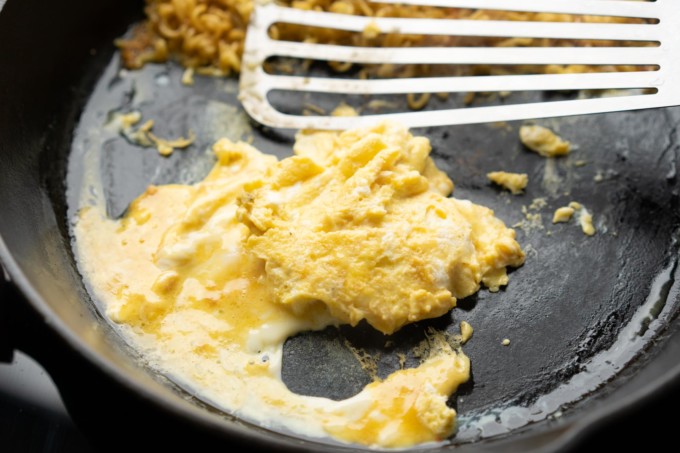
We can use cast iron cookware for everything from deep frying crispy sweet potato fries to stovetop grilling pork bulgogi, or having a really slick surface to cook eggs. When properly seasoned, we can use them for both non-stick cooking and baking. The more seasoned your cast-iron skillet, the more flavorful your food. Contrary to popular belief, cast iron is not difficult to use or clean.
Preheat your cast iron skillet on the stovetop for 5-10 minutes before adding food. Cast iron pans heat unevenly but retain heat well. Never cook cold food in a cold cast-iron skillet. It’s hot enough when your hand hovers over the pan and feels warm.
Cast iron pans and Dutch ovens can also be heated for 20-30 minutes in an oven. It is not necessary to preheat a cast iron pan before using it for baking. Once you’ve placed your food in the cast iron pan, it’s best to leave it alone. You can toss or flip your meal once the food easily dislodges off the pan’s bottom.
How to wash and care for cast iron
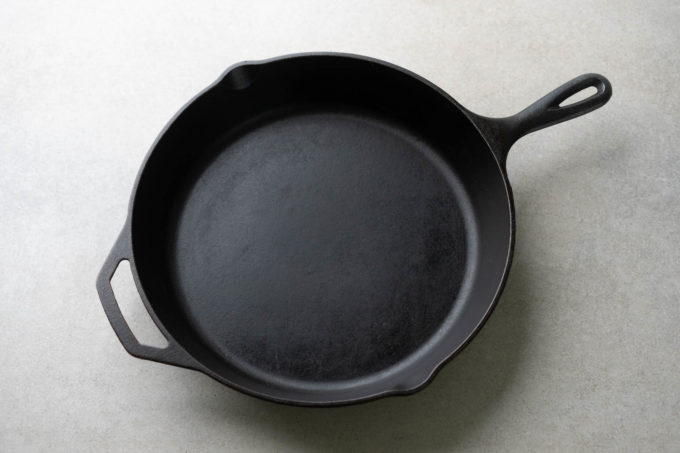
There are several things you need to know before you start using your cast iron cookware, whether you bought it new or finally got your family’s heirloom skillet. While they need to be treated with extra care, there are a few myths about cast iron pan care that you need to be aware of.
Cleaning a cast iron cookware for the first time
Wash your skillet as soon as you get it, whether it’s brand new or passed down from a family member. This wash requires hot, soapy water. Contrary to popular belief, soap is safe on cast iron pans.
Wash to remove factory residue or rust spots. Rinse and dry the pan thoroughly after this initial cleaning. If you take care of your cast iron cookware, you may only need to clean it once or twice a year.
Cleaning cast iron cookware after each use
Soap is thought to remove seasoning from cast iron cookware. Because seasoning is baked-on fat, it’s easy to believe soap can remove seasoning, grease, and dirt. Although seasoning is made up of fat, it is so polymerized that soap cannot remove it.
You’ll need steel wool or a strong lye solution to completely remove the seasoning. Removing seasoning from a cast iron pan takes some time and effort. Therefore, you can easily use soap without harming your cookware.
- While your pan is warm but not hot, use warm soapy water and a sponge to clean the cookware.
- For stubborn burnt-on bits, you can use kitchen sponges with a synthetic scrubber on the back, which is gentler than steel wool.
- To remove any remaining residue, use salt and lukewarm water as a mild abrasive that won’t damage the seasoning.
- Dry thoroughly with a kitchen towel or toilet paper. Cast iron should not be left wet after washing. Even the tough polymerized oil can’t stop the oxidation if the pan is left in water.
- After hand drying the pan, place it over a high flame. This will speed up the drying process.
Carbon steel pans
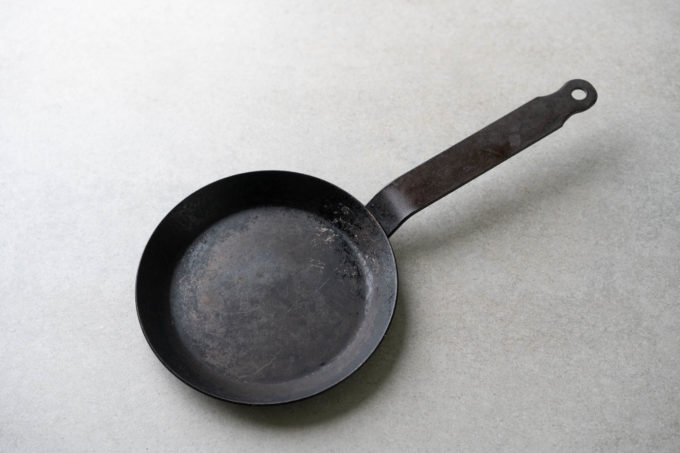
Carbon Steel Cookware is well-known for its French origins and widespread use in professional kitchens worldwide. However, it has recently started gaining popularity among home cooks as well. For the most part, it’s made of iron, with 1-2% carbon. It was developed in the 18th and 19th centuries alongside steel, stainless steel, and aluminum.
Carbon steel can be formed by rolling, stamping, or forging. In addition, it weighs less, has a smoother surface, is easier to heat up, and is less brittle than cast iron. Woks are popular cookware that is usually made of carbon steel.
We can use good carbon steel cookware for everything except cooking acidic dishes because that can wear down the seasoning. Acidic foods can strip seasoning from well-seasoned carbon steel cookware. Nevertheless, carbon steel is known for its long-lasting properties.
A carbon steel skillet will be significantly lighter compared to cast iron skillets of the same size. The pans are generally inexpensive, but some high-end options are available. Popular carbon steel cookware brands include Matfer Bourgeat, Lodge, Mauviel, and De Buyer.
Cooking with carbon steel pans
Carbon steel is a much better heat conductor than cast iron. It also cools down more quickly than cast iron, which is a bonus. Unlike cast iron, which has hot spots, carbon steel heats up more evenly. Searing, pan-frying, roasting, baking, and stir-frying are the best ways to use this pan. Carbon steel pans are a great alternative when cooking delicate foods like agedashi tofu and bánh xèo that tend to stick to cast-iron pans.
While carbon steel and cast iron can handle acidic foods like tomato sauce for long periods, the acid can cause the seasoning to wear away. Even though this erosion can result in metallic particles like iron being released into the food, it isn’t significant enough to affect your diet.
How to wash and care for carbon steel
It is important to know how to properly clean carbon steel cookware without damaging the seasoning. When done correctly, it’s not that hard to do. Because cast iron is porous, the seasoning permeates the pan from the outside in. For carbon steel, the seasoning is only superficial and builds up on the pan’s surface. Using abrasive steel wool or harsh soaps can remove the seasoning.
Step 1 – Wash the cookware with warm water. Use a paper towel or kitchen towel to remove any excess food and oil from your pan.
Follow steps 2-4 to remove stubborn residue. Otherwise, skip to step 5.
Step 2 – For stubborn residue, add 2 tablespoons of coarse salt and 2 tablespoons of vegetable or canola oil. Rub the salt and oil into the pan with a paper or kitchen towel. This will help loosen any leftover food.
Step 3 – Add enough water to cover the bottom of the pan and 2 tablespoons of salt on medium heat. Soon after it boils, scrape it with a wooden or rubber spatula. Once the stuck-on food has been removed from the pan, drain the water from it.
Step 4 – If all else fails, you can use steel wool and warm water to remove any stubborn food bits. Don’t worry about the scratches. The more you season and use your pan, the less noticeable any scratches are.
Step 5 – Wipe the water off the cookware using a paper or kitchen towel. Then, place it back on the burner and dry it out completely over medium heat to avoid rust. Once it’s completely dry, follow the steps for seasoning the cookware.
Seasoning cast iron and carbon steel pans
Seasoned and unseasoned cast iron and carbon steel cookware are available. The pans are seasoned every time they are used. Seasoning is nothing more than polymerized oil baked on. It also creates a nonstick surface and prevents rusting. While these cookware require special care, cast iron and carbon steel cookware are far better for your health and the environment than PFOA-containing cookware.
Seasoning and Re-Seasoning Your Cast Iron Cookware
Step 1 – Heat the cookware until water sizzles when dropped into it.
Step 2 – Apply a coat of oil to the pan.
Step 3 – Oil the inside of the pan with a basting brush, letting it seep in. The oil can then be rubbed into the pan with paper towels while the excess oil is absorbed.
Step 4 – Repeat Step 3 three to four times, stopping when the surface of the cookware is blackened.
Step 5 – Clean the pan after each use and re-apply a light coating of oil with a paper towel to the inside of the pan while it is still warm.
Seasoning and Re-Seasoning Your Carbon Steel Cookware
Step 1 – Clean the Pan. The first step is to remove the protective coating. Because coatings vary between manufacturers, it is best to follow the pan’s instructions. After that, thoroughly wash the pan.
Step 2 – Dry the Pan
Step 3 – Place it over the stove to cook off any remaining moisture.
Step 4 – Heat the pan before applying the first coat of oil.
Step 5 – Oil Sparingly. Using paper or a kitchen towel with oil, rub the oil all over the cookware.
Use a medium smoke point neutral oil for seasoning and cooking in carbon steel pans. Canola oil, sunflower oil, grapeseed oil, vegetable oil, and corn oil are all examples of these types of oils. Since carbon steel cookware heats up quickly, avoid using oils with high smoke points.









